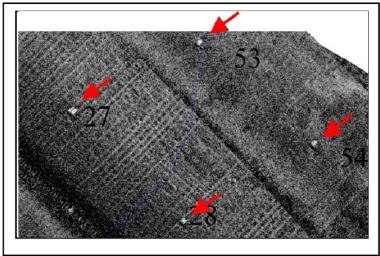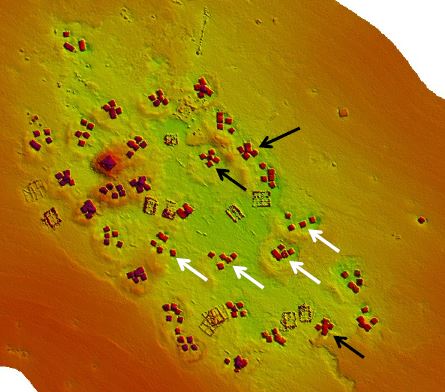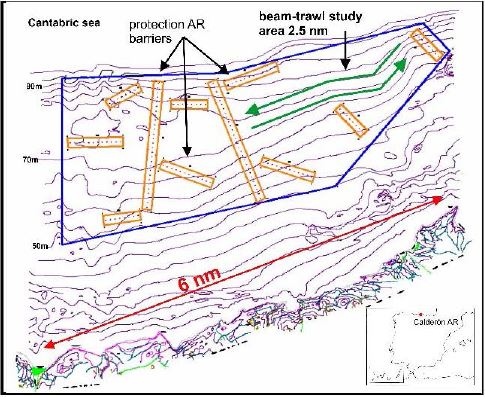7.2. Monitoring methods
Sampling methods used in studies associated with artificial reefs fall into two broad categories: non?destructive and destructive methods.
7.2.1.Monitoring the physical performance of artificial reefs
As already explained in Section 4.1, the introduction of artificial reefs into the marine environment acts as an open system with exchange of material and energy, altering the physical and biological features of the area where they are deployed. Artificial reefs can modify flow velocity and create turbulent intensity in and around the vicinity of the structures, which can lead to scour and changes in sediment accumulation in the surrounding area. The environmental changes on the adjacent seafloor can, in turn, physically affect the artificial structures. Thus the stability, and hence the efficiency, of an artificial reef will depend on the balance of scour, settlement and burial resulting from ocean conditions, as well as on human activities over time.
For example, to prolong the effects of a protection artificial reef over time, it is important that the reef units maintain their spatial position and do not burrow too much into the sediment (Manoukian et al., 2004).
Long?term monitoring of the physical performance of artificial reef systems is essential to understand how the sedimentary and oceanographic conditions (collectively known as coastal process associated with wave and current movements) affect different types of artificial reefs and how the physical conditions of the reef influence the succession of reef communities over time.
Acoustic systems (single?beam echosounder, MBES and side scan sonar) are efficient tools capable of monitoring the environmental (physical and biological) evolution around artificial reefs (Fig. 20), whereas visual dive and remotely operated vehicle inspections can be limited by water turbidity.

Figure 20. Side scan sonar georeferenced image of units in the protection Santanyi artificial reef, Mallorca, Balearic Islands, Spain (courtesy of Balearic Islands Government).
However, techniques such as single?beam echosounder and side scan sonar have spatial limitations and navigation uncertainties of the towfish as well as difficulty in three? dimensional positioning of the towfish during a survey. Conversely, high?frequency MBESs offer the potential of detecting and defining the fine?scale distribution of artificial reef units from a ship equipped with good control of sonar positioning through a survey, due to the very accurate navigation available from DGPS or similar systems (Fig. 21).

Figure 21. Multibeam echosounder image of on artificial reef in the Adriatic Sea, Italy, 21 years after deployment. Some reef sets have maintained their original structure (black arrows), while others have collapsed (white arrows) (courtesy of CNR?ISMAR Ancona).
These high?resolution systems are able to acquire 100 percent coverage of seabed geology and geomorphology over relatively broad spatial scales, offering an unprecedented level of resolution, coverage and spatial definition. In recent years, the application of acoustic? mapping methodology, in particular the use of acoustic ground?discrimination systems in conjunction with bottom sampling, has become common practice in monitoring and mapping seabed habitats (Naar et al., 1999; Cochrane and Lafferty, 2002; Foster?Smith et al., 2004; Manoukian et al., 2004, 2011; Jarrett et al., 2005; Jordan et al., 2005; Sala et al., 2007; Freitas et al., 2008).
Because acoustic data are less able to detect changes in the biological components of the seabed, classifications of different seabed environments tend to be driven largely by physical criteria (Kostylev et al., 2001; Freitas et al., 2003).
Mapping should start before the artificial reef deployment, be repeated just after the immersion of the structures to verify their right position, and continue over all the life of the artificial reef. Acoustic mapping of the seafloor before reef deployment not only provides a baseline against which post?installation assessments of sediments changes (scour and accumulation) can be based but is also very important to identify any unknown obstruction in the area which may have cultural or historical significance (i.e. ship wrecks) as well as any unchartered natural rocky reef.
7.2.2.Benthic communities
The deployment of new hard substrates may induce changes in the communities of the natural habitats as well as the development of new epibenthic communities (fauna and algae) which will colonize the artificial structures.
7.2.3.Soft?benthic communities
Artificial structures in the marine environment have the potential to influence adjacent soft sediment assemblages in several ways. This may be done indirectly, through the alteration of the physical and/or biological properties of the environment or through the direct placement of the structure including direct loss or disturbance of infaunal assemblages, changes to sediment characteristics, increased predation by fish and decapods on soft? bottom infauna, organic enrichment of sediments from excretion, and detritus of reef associated organisms. On the other hand, the organic matter produced by fish and other organisms associated to the reef represents additional food for many detritivorous and deposit?feeder benthic species, which tend to move close to the artificial reefs. In turn, these species may be preyed by other carnivorous benthic organisms, and both of them by fish. In addition, mollusc shells or other organisms (e.g. serpulids, calcareous algae) falling down from the artificial substrates to the surrounding seabed contribute to diversify the bottom habitat and, consequently, the natural soft?bottom communities.
Most of the research on infauna surrounding artificial reefs dealt with the macrofauna group?size components, but meiofauna should also be considered, being an important component of the interstitial infauna of the sublittoral sand sediments (Fenchel, 1978) that may significantly affect the structure of the macrofauna communities (Watzin, 1983).
As a primary aim is to assess the radius of influence of an artificial reef on the surrounding seabed community, samples should be collected as close as possible to the reef edge and at increasing distances from it (Fabi et al., 2002). The same should be done inside the reef to verify the influence of the different modules employed (Fig. 22). An adequate number of replicates should be forecasted at each site and at adequate time periods to assess spatial and temporal (e.g. seasonal, annual) variability.

Figure 22. Example of sampling plan of the soft?bottom benthic communities at an artificial reef (from Fabi et al., 2002).
7.2.4.Epibenthic and algal communities
The technical features of the artificial reef, such as the materials, shape, size and surface rugosity, should be taken into account in evaluating the epibenthic communities. Beside the animal component, the study on macroalgae is also important to assess the ecological role of an artificial reef, for example in terms of increasing oxygen production; trapping of sediments, thus increasing food supply for detritivores; and creation of nurseries and food sources for herbivorous fish (Falace and Bressan, 1996). Three main aspects should be assessed: presence/absence, luxuriance and fertility.
As in the case of soft?bottom communities, adequate spatial and temporal sampling is required as well as a sufficient number of replicates in space and time. The number and size of samples depend on the spatial variability: a higher variability requires more and larger samples (Moreno, 1996). Sampling must be simple and fast since it must be carried out by scuba divers. For this reason, it is important that the protocol is standardised and well defined.
7.2.5.Sampling methods
Non?destructive methods
Underwater observations: in situ observations include both qualitative and quantitative methods to establish lists and zonation patterns, and include observations or photographic techniques taken by divers, if depth permits, or by remote surface deployed cameras. Photography may be used to estimate the fauna and flora species composition, the number of organisms, the percent cover and the relative density of the sessile community. Moreover, it allows for an objective evaluation and the creation of a reference collection.
Such methods can be used for soft? and hard?bottom communities, and are useful for dominant and large organisms. However, they are likely to underestimate small or understory components of the community.
Moreover, the records obtained through these techniques can be affected by low taxonomic precision, especially for small?sized organisms and algae. In addition, these methods require a good water transparency and, in temperate waters, may be difficult to be applied in all seasons.
Destructive methods
Grab and box?corer samplers: these instruments are usually employed to sample communities inhabiting the soft?bottoms outside an artificial reef and between the structures constituting the reef. Grab samplers (e.g. Van Veen) and box corers have a known volume and can be appropriate in quantitative studies. Moreover, they are surface operated and do not require underwater work; however, their positioning on the seabed is not precise. In addition, the penetration of these instruments inside sandy bottoms may be difficult. Box corers have a smaller capacity than grabs and usually require a high number of samples to obtain an adequate sediment volume.
Dredges: they can be used to sample soft?bottom communities outside the artificial reef; however they cannot be used inside the reef due to the presence of the reef structures. Dredges are not able to adequately sample predefined quantities of sediment and hence not useful in the case of quantitative studies (Castelli et al., 2003).
Suction samplers: these samplers are used to investigate soft?bottom benthic communities, but may be useful for interstitial fauna living on the horizontal walls of the hard substrates (Spagnolo et al., 2004; Fabi et al., 2006). These instruments allow for sampling the exact sampling point because they are directly operated by scuba divers, but they may require a great sampling effort to collect samples of adequate size and/or a sufficient number of replicates.
Scraping technique: this technique is commonly employed to sample hard?bottom communities (animals and algae). Similar to the suction sampling, it has the advantage to sample at the sample site but it may require a greater effort by divers. In addition, part of the sample is likely to be lost, especially small?sized organisms, due to underwater currents.
7.2.6.Fish assemblage
7.2.7.Sampling methods
Non?destructive methods
Underwater visual census (UVC): UVC by divers is historically the most common non? destructive method used, and a range of techniques to monitor fish assemblages in a variety of shallow marine habitats has been developed (Bortone and Kimmel, 1991). The most common are:
• Strip transect: the diver swims along a transect of pre?established length in a pre? established time interval listing the species encountered.
• Point count: the diver stands at a fixed point and enumerates the organisms observed within a prescribed area or volume in a pre?established time interval.
• Species?time random count: this method is based on the principle that abundant species are likely to be encountered first than the rarer ones. The observer swims randomly over the survey area for a predefined time period either simply recording the species encountered or listing them in the order in which they were initially seen.
• Combinations of methods.
In situ visual methods are relatively rapid, provide adequate levels of replication and are capable of recording a broad suite of variables, e.g. relative abundance, density size structure species composition and habitat characteristics (Bortone et al., 2000; Samoilys and Carlos, 2000). However, the limitations of diver?based methodologies have been well documented (Thresher and Gunn, 1986; Lincoln?Smith, 1988, 1989; Bombace et al., 1997; Thompson and Mapstone, 1997; Kulbicki, 1998) and relate to the physical limitations (e.g. water depth and visibility) and species?specific sources of "detection heterogeneity" (Kulbicki, 1998; Macneil et al., 2008), which can be summarized as the ability of the diver to see fish accurately and record their presence under variable conditions (Sale, 1997). Moreover, the different fish species react in different ways to the presence of divers: some escape whereas others come closer, making it difficult to carry out a census with the same level of accuracy.
Baited remote underwater video (BRUV): recent innovations in the development of video technology have resulted in the widespread use of BRUV as a means to monitor fish populations in a variety of habitats (Cappo et al., 2006). BRUV systems have however inherent biases such as difficulties in determining the area sampled due to variables associated with the dispersion of bait (Priede and Merrett, 1996, 1998; Bailey and Priede, 2002), conservative relative abundance estimation (Farnsworth et al., 2007), reliance on acceptable visibility and an inability to detect more cryptic reef associated species (Watson et al., 2005).
Hydroacoustic techniques: the most recent advancement in artificial reef research involves using stationary or mobile hydroacoustic technology (e.g. echosounders for fish, MBES) to study fish abundance, distribution and behaviour in specific areas.
Echosounders for fish have been successfully employed in surveying fish assemblages at hydroelectric facilities in riverine environments and around oil and gas platforms (Thorne et al., 1990; Thorne, 1994; Stanley et al., 1994; Stanley and Wilson, 1998; Soldal et al., 2002). However, applying this technique to artificial reefs has been very limited thus far (Thorne et al., 1989; Fabi and Sala, 2002; Sala et al., 2007; Kang et al., 2011). The advantage of the stationary hydroacoustic methods in respect to the mobile method is that in the former, when strategically placed and combined with computerized data records, the transducer arrays allow to collect long?term, time?series data along the entire water column or at specific depths.
The newer generation of MBES is able to detect the seafloor and the water column at the same time. An aspect that is commonly ignored when assessing the fish assemblage at an artificial reef is the current state of the structures. Studies usually refer to the initial arrangement of the artificial substrates, but do not take into account movements and alterations that may occur over time due to environmental and anthropic factors, although the arrangement, distance, shape and dimensions of the reef units and/or reef sets can strongly affect the composition and behaviour of the reef fish assemblage (Nakamura, 1985; Bombace, 1989; Okamoto, 1991). Relief imagery produced from multibeam bathymetric data can provide valuable and detailed basemaps for seafloor investigation and interpretation (Todd et al., 1999; Mosher and Thomson, 2002), thus helping better understand the evolution of the fish assemblage associated to an artificial reef in respect to the status of the substrates. These data associated to the data recorded along the water column allow to detect the behaviour of fish inside the artificial reef and to map the spatial distribution and abundance of fish in respect to the reef structures (Fig. 23).

Figure 23: Multibeam echosounder images of fish schools around artificial reef structures in the Adriatic Sea, Italy (courtesy of CNR?ISMAR Ancona).
In general, the main disadvantage of hydroacoustic techniques is the difficulty of identifying the species, especially in a mixed?species assemblage such as that typically inhabiting an artificial reef.
Destructive methods
These methods include adaptations of commercial fishing techniques such as traps, longlining and setnetting (Gannon et al., 1985; Kelch et al., 1999) as well as trawling.
Trawling is the less suitable technique because, due to the physical presence of the artificial reef structures, it must be performed at a certain distance from the reef. Consequently, as the radius of influence of an artificial reef on the different species changes at increasing distances from it, trawling cannot allow to fully investigate the assemblage inhabiting the reef. Nevertheless, protection artificial reefs that aim to protect wide areas can be designed in such a way as to include a free internal zone where it would be possible to carry out surveys with towed gears. This is the case of an artificial reef constructed in an area of the Cantabric Sea and surveyed since 1984 to study fish demersal stocks and benthic macrofauna. The position of the artificial units was planned so to leave the survey area free. Artificial reefs consist in groups of concrete blocks with a separation of 130 m between blocks and of 2 km between groups of blocks. The surface area occupied by the blocks is less than 2 percent of the whole area (Fig. 24; Serrano et al., 2011).
The advantages related to the use of fishing gears include the availability of specimens to study the effect of the artificial reef on growth, diet and sexual reproduction. Moreover, the possibility to sample at day and night and in each season over the year, independently from water transparency, allows studying the daily behaviour of species assemblages as well as the seasonal changes of the reef fish community.
Oppositely, the potential habitat degradation due to the use of fishing gears, the impossibility to observe the behavioural aspect of the species associated with the artificial reefs, and the possible underestimation in terms of both size and species due to the selectivity of the gear employed, are clear weaknesses of such approaches. Moreover, these methodologies are often prohibited in sensitive areas such as marine parks (Willis et al., 2000; Lipej et al., 2003; Cappo et al., 2004).

Figure 24: Protection artificial reef of Calderon, Cantabria coast, deployed in an area subjected to scientific trawl surveys, Spain (courtesy of J.J. Goutayer Garcia).
However, the crucial aspect in the investigation of the biological assemblages associated with artificial reefs is the capacity to standardize results from studies using different methodologies. For example, there are situations where one study uses UVC and another study uses experimental fishing surveys in the same area.
The new monitoring perspectives to assess the effects of an artificial reef refer to two critical points:
• no single technique is capable of completely describing the communities associated to an artificial reef;
• a combination of techniques should be employed and adjusted according to the morphological and geographical characteristics of the reef areas.